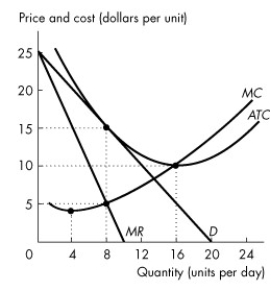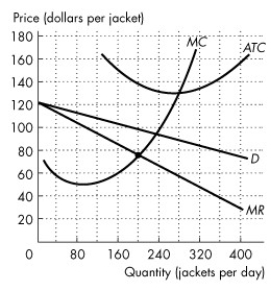A) A firm must lower its price to sell a greater quantity.
B) A firm can never incur an economic loss.
C) Price is never more than marginal cost.
D) Firms offer identical products.
E) The most a firm can make is zero economic profit.
Correct Answer

verified
Correct Answer
verified
Multiple Choice
Use the figure below to answer the following questions.  Figure 13.2.5
-Refer to Figure 13.2.5.The figure shows the situation facing Smart Digit,Inc. ,a firm in monopolistic competition that produces calculators.The firm's markup is ________ per calculator.
Figure 13.2.5
-Refer to Figure 13.2.5.The figure shows the situation facing Smart Digit,Inc. ,a firm in monopolistic competition that produces calculators.The firm's markup is ________ per calculator.
A) zero
B) $2
C) $4
D) $6
E) $10
Correct Answer

verified
Correct Answer
verified
Multiple Choice
The profit-maximizing condition for a firm in monopolistic competition is to produce the quantity at which
A) marginal cost equals price.
B) price equals marginal revenue.
C) average total cost equals price.
D) marginal cost equals marginal revenue.
E) average variable cost equals price.
Correct Answer

verified
Correct Answer
verified
Multiple Choice
An industry with a high four-firm concentration ratio may have little monopoly power if
A) its production is geographically concentrated.
B) its barriers to entry are low.
C) its barriers to entry are high.
D) there are no international producers of the product.
E) there are no close substitutes for its product.
Correct Answer

verified
Correct Answer
verified
Multiple Choice
Use the figure below to answer the following questions.  Figure 13.2.5
-Refer to Figure 13.2.5 The figure shows the situation facing Smart Digit,Inc. ,a firm in monopolistic competition that produces calculators.What is the firm's economic profit per day?
Figure 13.2.5
-Refer to Figure 13.2.5 The figure shows the situation facing Smart Digit,Inc. ,a firm in monopolistic competition that produces calculators.What is the firm's economic profit per day?
A) zero
B) between $1 and $700
C) between $701 and $900
D) more than $901
E) less than zero
Correct Answer

verified
Correct Answer
verified
Multiple Choice
In monopolistic competition,advertising costs
A) are variable costs.
B) can result in the firm producing an amount of output such that its average total cost is lower than if it did not advertise.
C) shift the ATC curve downward.
D) shift the AVC curve upward.
E) shift the MC curve upward.
Correct Answer

verified
B
Correct Answer
verified
Multiple Choice
Monopolistic competition might be efficient if
A) firms invested in technology that decreased the marginal cost of production.
B) more firms entered the industry.
C) firms left the industry.
D) the loss that arises because the quantity produced is less than the efficient quantity is offset by the gain that arises from having a greater degree of product variety.
E) firms made more use of brand names.
Correct Answer

verified
Correct Answer
verified
Multiple Choice
Advertising costs of a monopolistically competitive firm are
A) greater than a monopoly and the same as a perfectly competitive firm.
B) greater than a perfectly competitive firm.
C) less than a perfectly competitive firm.
D) the same as a monopoly.
E) less than a monopoly.
Correct Answer

verified
Correct Answer
verified
Multiple Choice
In the long run,all firms in an industry that is monopolistically competitive
A) produce at their efficient scale.
B) set price equal to marginal cost.
C) incur an economic profit.
D) make an economic profit.
E) make zero economic profit.
Correct Answer

verified
Correct Answer
verified
Multiple Choice
Use the figure below to answer the following question.  Figure 13.2.7
-Refer to Figure 13.2.7.The figure shows the demand,marginal revenue,and cost curves for a monopolistically competitive firm in the long run.The firm has excess capacity of
Figure 13.2.7
-Refer to Figure 13.2.7.The figure shows the demand,marginal revenue,and cost curves for a monopolistically competitive firm in the long run.The firm has excess capacity of
A) 4 units.
B) 8 units.
C) 16 units.
D) $10.
E) $5.
Correct Answer

verified
B
Correct Answer
verified
Multiple Choice
Use the information below to answer the following questions. Fact 13.3.3 Suppose that Roots' marginal cost of a jacket is a constant $125.00 and the total fixed cost at one of its stores is $1,500 a day.This store sells 20 jackets a day,which is its profit-maximizing number of jackets.Then the stores nearby start to advertise their jackets.The Roots store now spends $2,000 a day advertising its jackets,and its profit-maximizing number of jackets sold jumps to 70 a day. -Refer to Fact 13.3.3.In the long run,Roots' economic profit is
A) positive.
B) negative.
C) zero.
D) greater than the economic profit of its competitors.
E) less than the economic profit of its competitors.
Correct Answer

verified
Correct Answer
verified
Multiple Choice
In the long run,a monopolistically competitive firm produces the output at which price equals
A) marginal cost.
B) marginal revenue.
C) average variable cost.
D) average total cost.
E) average fixed cost.
Correct Answer

verified
Correct Answer
verified
Multiple Choice
The key feature of monopolistic competition that distinguishes it from perfect competition is
A) many sellers.
B) barriers to entry.
C) perfectly elastic demand.
D) product differentiation.
E) perfectly inelastic demand.
Correct Answer

verified
Correct Answer
verified
Multiple Choice
Within a monopolistically competitive industry,
A) firms can freely enter and exit,and economic profit is zero in the long run.
B) firms can freely enter and exit,and economic profit is greater than zero in the long run.
C) there are some barriers to entry and exit,and economic profit is zero in the long run.
D) there are some barriers to entry and exit,and economic profit is greater than zero in the long run.
E) firms can freely enter and exit,and economic profit is zero in the short run.
Correct Answer

verified
Correct Answer
verified
Multiple Choice
The four-firm concentration ratio tells us the percentage of ________ for the four largest firms in an industry.
A) employment
B) accounting profit
C) economic profit
D) the value of sales
E) physical output
Correct Answer

verified
Correct Answer
verified
Multiple Choice
The decision to undertake product development in monopolistic competition is made by comparing the
A) marginal benefit of product development to the marginal cost of product development.
B) marginal revenue of product development to the average total cost of product development.
C) total revenue of product development to the total cost of product development.
D) firm's expenditure on product development to expenditures by competing firms.
E) total benefit of product development to the total cost of advertising.
Correct Answer

verified
Correct Answer
verified
Multiple Choice
When the Herfindahl-Hirschman Index (HHI) is greater than 2,500,
A) the market is very competitive.
B) a monopoly exists.
C) there are many producers in the market.
D) the market is moderately competitive.
E) the market is uncompetitive.
Correct Answer

verified
Correct Answer
verified
Multiple Choice
Which one of the following characteristics is shared by perfect competition and monopolistic competition?
A) Firms face a downward-sloping demand curve.
B) Profit-maximizing quantity occurs where MC = MR.
C) Long-run equilibrium price equals minimum ATC.
D) Firms make an economic profit in the long run.
E) Demand is perfectly elastic.
Correct Answer

verified
Correct Answer
verified
Multiple Choice
Use the figure below to answer the following questions.  Figure 13.2.6
-Refer to Figure 13.2.6,which shows the demand curve,marginal revenue curve and cost curves faced by Gap.Gap's economic ________ is ________ a day.
Figure 13.2.6
-Refer to Figure 13.2.6,which shows the demand curve,marginal revenue curve and cost curves faced by Gap.Gap's economic ________ is ________ a day.
A) loss;$8,000
B) loss;$13,000
C) profit;$7,200
D) profit;$13,000
E) loss;$8,960
Correct Answer

verified
A
Correct Answer
verified
Multiple Choice
A monopolistically competitive firm is able to influence the price of what it sells because of
A) barriers to entry.
B) economies of scale.
C) product differentiation.
D) the fact there are many buyers.
E) inelastic demand.
Correct Answer

verified
Correct Answer
verified
Showing 1 - 20 of 136
Related Exams